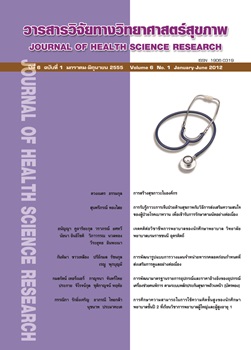การพัฒนารูปแบบการวางแผนจำหน่ายทารกคลอดก่อนกำหนดที่ส่งเสริมการดูแลอย่างต่อเนื่อง
Main Article Content
บทคัดย่อ
บทคัดย่อ
การวิจัยปฏิบัติการแบบมีส่วนร่วมนี้มีวัตถุประสงค์เพื่อพัฒนารูปแบบการวางแผนจำหน่ายทารกคลอดก่อนกำหนดที่ส่งเสริมการดูแลอย่างต่อเนื่อง ของโรงพยาบาลปทุมธานี ผู้ร่วมวิจัย ได้แก่ ทีมสหสาขาวิชาชีพ จำนวน 9 คน และมารดาทารกคลอดก่อนกำหนด จำนวน 16 คน ดำเนินการวิจัย 3 ระยะ ได้แก่ 1) ขั้นเตรียมการ คือ เตรียมความพร้อมผู้วิจัย ศึกษาข้อมูลพื้นฐานหน่วยงาน ประสานงานผู้มีส่วนเกี่ยวข้อง และสร้างสัมพันธภาพกับผู้ร่วมวิจัย 2) ขั้นดำเนินการคือ วิเคราะห์ปัญหาและสาเหตุของปัญหาการจำหน่าย วางแผนจำหน่าย ปฏิบัติตามแผน สังเกต/สะท้อนการปฏิบัติและปรับปรุงแผน 3) ขั้นประเมินผลของรูปแบบที่เกิดจากการพัฒนาทั้งสิ้น 2 วงจร เก็บรวบรวมข้อมูลเชิงปริมาณและเชิงคุณภาพ วิเคราะห์ข้อมูลเชิงปริมาณใช้ค่าความถี่ ร้อยละ ค่าเฉลี่ย ส่วนเบี่ยงเบนมาตรฐาน ข้อมูลเชิงคุณภาพใช้วิเคราะห์เนื้อหา จากนั้นนำรูปแบบที่ได้ไปทดลองใช้กับมารดาและทารกคลอดก่อนกำหนด จำนวน 10 ราย
ผลการวิจัย พบว่ารูปแบบการวางแผนจำหน่ายที่พัฒนาขึ้น ประกอบด้วย 1) โครงสร้างด้านบุคลากร โดยมีทีมสหสาขาวิชาชีพที่เกี่ยวข้อง ได้แก่ กุมารแพทย์ เภสัชกร พยาบาล และเวชกรรมสังคม 2) การวางแผนจำหน่าย 5ขั้นตอน คือ (1) ประเมินปัญหาความต้องการ (2) วินิจฉัยปัญหา (3) กำหนดแผนจำหน่าย ประกอบด้วย แผนผังทำงานเป็นทีม แบบบันทึกการจำหน่าย คู่มือการจำหน่ายและการดูแลทารกคลอดก่อนกำหนด (4) ปฏิบัติตามแผน มีกิจกรรมการปฏิบัติ รวม 7 วัน โดยใช้ D-METHOD และ (5) ประเมินผลและส่งต่อการดูแลต่อเนื่อง ประเมินผลการใช้รูปแบบ พบว่ามารดามีความรู้ ทักษะในการดูแลเพิ่มขึ้น มีความพึงพอใจในระดับดีมาก ทารกไม่กลับมารักษาซ้ำภายใน28 วัน หลังจำหน่ายจากโรงพยาบาล และทีมสหสาขาวิชาชีพมีความพึงพอใจในระดับดีมาก จากผลการวิจัยแสดงให้เห็นว่าการใช้กระบวนการพัฒนาที่เน้นการมีส่วนร่วมของผู้ที่มีส่วนเกี่ยวข้องทั้งหมดเป็นปัจจัยแห่งความสำเร็จ และสามารถนำไปสู่การปฏิบัติการวางแผนจำหน่ายทารกคลอดก่อนกำหนดที่มีคุณภาพได้จริงอย่างยั่งยืน
คำสำคัญ: รูปแบบการวางแผนจำหน่าย; ทารกคลอดก่อนกำหนด; การดูแลอย่างต่อเนื่อง
Abstract
The objective of this participatory action research was to develop a discharge planning model topromote continuity care for pre-term infants who were admitted into and inpatient unit of PathumtaniHospital, Pathumtani Province. Participants comprised nine persons of multidisciplinary team and 16mothers of pre-term infants. Three phases were carried out for the study as 1) preparation phaseinvolved preparing the researchers, studying basic information of the unit, coordinating involved people,and building relationships among researchers; 2) implementation phase included analyzing problems and causes, discharge planning, implementing plan,and improving plan; 3) evaluation phase focusedon evaluating the developed model for 2 cycles.
The data were collected by means ofinterviews, participatory observation, focus groupdiscussion, writing field notes, and takingphotographs. Quantitative data were analyzedusing percentage, means and standard deviation.Qualitative data analysis was carried out throughcoding and developing themes following contentanalysis method. Then, the developed plan ofdischarge planning was implemented to 10 preterminfants.
The results revealed that the dischargeplanning model was developed by a hospital’smultidisciplinary team consisting of a pediatrician,pharmacists, and nurses. The team determineddaily activities for pre-term infants care andrecovery based on the application of the DMETHODmodel. The discharge planning modelwas operated within seven days while the preterminfants stayed in the hospital. This modelincluded a discharge planning model guideline ofmultidisciplinary team, a working flowchart for themultidisciplinary team, a discharge planning record,and a handbook of proper pre-term infants careform. After this discharge planning wasimplemented, it was revealed that the mothers ofthe pre-term infants’ knowledge was improved,and they were very satisfied with dischargeplanning model. Moreover, the multidisciplinaryteam was very satisfied with the dischargeplanning model and they were able to practicefollowing the discharge planning. In addition,during the conduction of this study, the pre-terminfants were discharged from the hospital within seven days and had no complications.There wasno re-admission of these pre-term infants. Theresearch findings conclude that the dischargeplanning model for pre-term infants to promotecontinuity care by a hospital’s multidisciplinaryteam, throughout the process of ParticipatoryAction Research is one of the effective dischargeplanning strategies.
Key words: Development of Discharge PlanningModel; Pre-term Infants; Continuity Care
Downloads
Article Details
บทความที่ได้รับการตีพิมพ์เป็นลิขสิทธิ์ของวิทยาลัยพยาบาลบรมราชชนนี จังหวัดนนทบุรี
ข้อความที่ปรากฏในบทความแต่ละเรื่องในวารสารวิชาการเล่มนี้เป็นความคิดเห็นส่วนตัวของผู้เขียนแต่ละท่านไม่เกี่ยวข้องกับวิทยาลัยพยาบาลบรมราชชนนี จังหวัดนนทบุรี และคณาจารย์ท่านอื่น ในวิทยาลัยฯ แต่อย่างใด ความรับผิดชอบองค์ประกอบทั้งหมดของบทความแต่ละเรื่องเป็นของผู้เขียนแต่ละท่าน หากมีความผิดพลาดใด ๆ ผู้เขียนแต่ละท่านจะรับผิดชอบบทความของตนเองแต่ผู้เดียว


